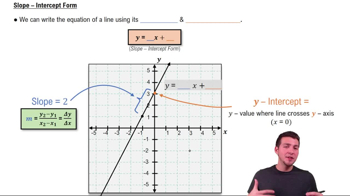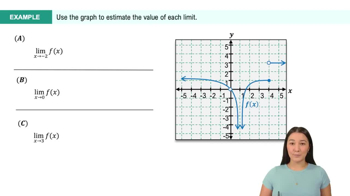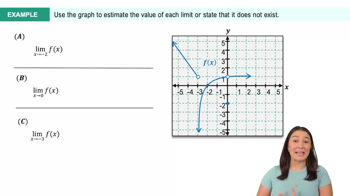Table of contents
- 0. Functions7h 52m
- Introduction to Functions16m
- Piecewise Functions10m
- Properties of Functions9m
- Common Functions1h 8m
- Transformations5m
- Combining Functions27m
- Exponent rules32m
- Exponential Functions28m
- Logarithmic Functions24m
- Properties of Logarithms34m
- Exponential & Logarithmic Equations35m
- Introduction to Trigonometric Functions38m
- Graphs of Trigonometric Functions44m
- Trigonometric Identities47m
- Inverse Trigonometric Functions48m
- 1. Limits and Continuity2h 2m
- 2. Intro to Derivatives1h 33m
- 3. Techniques of Differentiation3h 18m
- 4. Applications of Derivatives2h 38m
- 5. Graphical Applications of Derivatives6h 2m
- 6. Derivatives of Inverse, Exponential, & Logarithmic Functions2h 37m
- 7. Antiderivatives & Indefinite Integrals1h 26m
- 8. Definite Integrals3h 25m
1. Limits and Continuity
Introduction to Limits
Problem 2.2.27
Textbook Question
Use a graph of f to estimate or to show that the limit does not exist. Evaluate f(x) near to support your conjecture.
;
 Verified step by step guidance
Verified step by step guidance1
Identify the function and the point of interest: We have \( f(x) = \frac{x-2}{\ln|x-2|} \) and we are interested in the limit as \( x \to 2 \).
Recognize the indeterminate form: As \( x \to 2 \), both the numerator \( x-2 \) and the denominator \( \ln|x-2| \) approach 0, indicating a \( \frac{0}{0} \) indeterminate form.
Apply L'Hôpital's Rule: Since we have a \( \frac{0}{0} \) form, we can use L'Hôpital's Rule, which involves differentiating the numerator and the denominator separately.
Differentiate the numerator and denominator: The derivative of the numerator \( x-2 \) is 1, and the derivative of the denominator \( \ln|x-2| \) is \( \frac{1}{x-2} \).
Evaluate the new limit: Substitute the derivatives back into the limit expression to get \( \lim_{x \to 2} \frac{1}{\frac{1}{x-2}} \), which simplifies to \( \lim_{x \to 2} (x-2) \). Analyze this limit to determine if it exists or not.
Recommended similar problem, with video answer:
 Verified Solution
Verified SolutionThis video solution was recommended by our tutors as helpful for the problem above
Video duration:
5mPlay a video:
Was this helpful?
Key Concepts
Here are the essential concepts you must grasp in order to answer the question correctly.
Limits
A limit describes the behavior of a function as its input approaches a certain value. It is essential for understanding continuity and the behavior of functions near points where they may not be explicitly defined. In this context, we are interested in the limit of f(x) as x approaches 2, which helps determine the function's value or behavior at that point.
Recommended video:

One-Sided Limits
Continuity
A function is continuous at a point if the limit of the function as it approaches that point equals the function's value at that point. For the function f(x) given, checking continuity at x = 2 involves evaluating the limit as x approaches 2 and comparing it to f(2). If they are not equal, the function is discontinuous at that point.
Recommended video:

Intro to Continuity
Indeterminate Forms
Indeterminate forms occur in calculus when evaluating limits leads to expressions like 0/0 or ∞/∞, which do not provide clear information about the limit's value. In this case, as x approaches 2, both the numerator and denominator of f(x) approach 0, indicating an indeterminate form. Techniques such as L'Hôpital's Rule or algebraic manipulation may be needed to resolve these forms and find the limit.
Recommended video:
Guided course

Slope-Intercept Form

 6:47m
6:47mWatch next
Master Finding Limits Numerically and Graphically with a bite sized video explanation from Callie
Start learning




